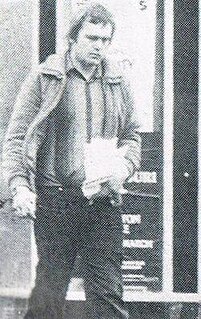Related Research Articles

The British Movement (BM), later called the British National Socialist Movement (BNSM), is a British Neo-Nazi organisation founded by Colin Jordan in 1968. It grew out of the National Socialist Movement (NSM), which was founded in 1962. Frequently on the margins of the British far-right, the BM has had a long and chequered history for its association with violence and extremism. It was founded as a political party but manifested itself more as a pressure and activist group. It has had spells of dormancy.
John Kingsley Read was chairman of the National Front (NF) from 1974 to 1976 and a holocaust denier, who founded the National Party.
Column 88 was a neo-Nazi paramilitary organisation based in the United Kingdom. It was formed in the early 1970s, and disbanded in the early 1980s. The members of Column 88 undertook military training under the supervision of a former Royal Marine Commando, and also held regular gatherings attended by neo-nazis from all over Europe. The name is code: the eighth letter of the alphabet 'HH' represents the Nazi greeting 'Heil Hitler'. Journalist Martin Walker described Column 88 as a "shadow paramilitary Nazi group".

The White Defence League (WDL) was a British neo-Nazi political party. Using the provocative marching techniques popularised by Oswald Mosley, its members included John Tyndall.
The British Democratic Party (BDP) was a short-lived far-right political party in the United Kingdom. A breakaway group from the National Front, the BDP was severely damaged after it became involved in a gun-running sting and was absorbed by the British National Party.
The National Party of the United Kingdom (NP) was a short-lived splinter party from the British National Front (NF). It was formed on 6 January 1976, and was dissolved in 1984.
The Constitutional Movement was a right wing political group in the United Kingdom. It was formed in 1979 by Andrew Fountaine as the National Front Constitutional Movement, a splinter group from the National Front. Offering a more moderate alternative to the NF, the Constitutional Movement claimed to have 2000 members by 1980.
Martin Guy Alan Webster is a British neo-nazi, a former leading figure on the far-right in the United Kingdom. An early member of the National Labour Party, he was John Tyndall's closest ally, and followed him in joining the original British National Party, the National Socialist Movement and the Greater Britain Movement. Webster also spent time in prison for helping to organise a paramilitary organisation, Spearhead, and was convicted under the Public Order Act 1936. Rumours of his homosexuality led to him becoming vilified in far-right circles, and he quietly disappeared from the political scene.
Raymond Hill was a former leading figure in the British far right who went on to become a well-known informant. A sometime deputy leader of the British Movement and a founder member of the British National Party, Hill also secretly worked for Searchlight in feeding information about the groups' activities.

The Herstigte Nasionale Party is a South African political party which was formed as a far-right splinter group of the now defunct National Party in 1969. The party name was commonly abbreviated as HNP, although colloquially they were also known as the Herstigtes.
Keith Thompson is a veteran figure in the British far-right who has been active in a number of movements down the years.

The League of St George is a neo-Fascist organisation based in the United Kingdom. It has defined itself as a "non-party, non-sectarian political club" and, whilst forging alliances with different groups, has eschewed close links with other extremist political parties.

The Order of Flemish Militants – originally the Flemish Militants Organisation – was a Flemish nationalist activist group in Belgium defending far-right interests by propaganda and political action. Established in 1949, they helped found the People's Union in 1954, a Belgian political party. The links between the extremist VMO and the VU lessened as the party moved towards the centre. In later decades the VMO would become linked to neo-Nazism and a series of paramilitary attacks on immigrants and leftists before disappearing by the late 1980s.
Denis Pirie is a veteran of the British far right scene who took a leading role in a number of movements.

Anthony Hancock was a publisher who created literature for British far right groups and a member of such organisations in the United Kingdom.
Alan Vivien Hancock was one of the early leaders of the Racial Preservation Society (RPS). He was formerly a member of the British Union of Fascists (BUF) which was formed in 1932 by ex-Labour government minister Sir Oswald Mosley and was a union of several small, extreme nationalist parties. Hancock formed part of a three-man leadership team in the RPS who came from the BUF, alongside Ted Budden and Jimmy Doyle.

The White Liberation Movement was a small but notorious South African neo-Nazi organisation which became infamous after being banned under the Apartheid regime, the first right-wing organisation to be so banned. It regarded itself as the most far-right organisation in South Africa.
The Racial Preservation Society was a far-right pressure group opposed to immigration and in favour of white nationalism, national preservation and protection in the United Kingdom in the 1960s.
References
- ↑ Hill, Ray and Bell, Andrew The Other Face of Terror Grafton (1988) p56, pp67-68
- ↑ Term used by former member
- ↑ Hill, Ray and Bell, Andrew The Other Face of Terror Grafton (1988) p56, pp70
- ↑ Baron, Alexander Jew-Haters, Black-Haters, violent Criminals, hypocrites and liars condemned out of their own mouths 2nd edition Anglo-Hebrew Publishing p9 ISBN 1-898318-07-7
- ↑ Article from (Johannesburg) Sunday Express 4 February 1979 Archived 7 October 2011 at the Wayback Machine
- ↑ Hill, Ray and Bell, Andrew The Other Face of Terror Grafton (1988) p70
- ↑ It is listed as among the most "notorious" of paramilitary organisations in Johann van Rooyen Hard Right: The New White Power in South Africa IB Tauris (1994) p91-92
- ↑ "GTD ID:198012100001". Global Terrorism Database. Retrieved 17 July 2022.
- ↑ Hill, Ray and Bell, Andrew The Other Face of Terror Grafton (1988)p72
- ↑ Allen, John Rabble-Rouser for Peace: The Authorised Biography of Desmond Tutu Rider 2006 p207
- ↑ Truth and Reconciliation Commission of South Africa Report Volume 2 p654
- ↑ "Right wing Wit Kommando bombs academic's office". South African History Online. Retrieved 17 July 2022.
